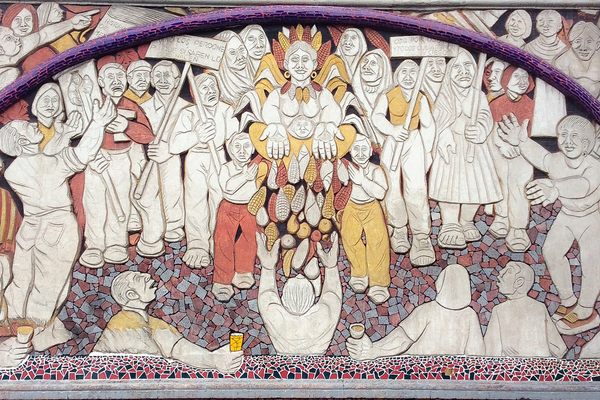About
In 1943, when the ground of Dionisio Pulido's farm split open and steam burst through the gap, he probably did not realize that he was witnessing the birth of a volcano. The creation and the eruption of this new volcano, called Paricutín, led to the destruction of the town of San Juan Parangaricutiro.
Today the volcano, its lava fields, and the towers that remain from San Juan's church are a tourist attraction. A series of colorful murals illustrating the history of Paricutín and the people of the region can be found at the visitor's center in Angahuan, the nearest town. A majority of the murals are the work of José Luis Soto.
Soto, who was born in the neighboring state of Guanajuato in 1955, is known for his colorful mosaic murals. His works in Angahuan decorate the outer walls of four trojes, a type of wood cabin. These trojes break with tradition because they are built out of sturdier materials, in order to sustain the weight of the mosaics. The murals depict the beliefs and customs of the indigenous Purépecha people, many of whom live in Michoacán state.
One of the murals depicts the Sun deity Tata-Juriata as one of the entities that originated life, and its fire is related to the one that gave birth to Paricutín. Another depicts a scene of Purépecha women across generations, highlighting the importance of matriarchal relations in their culture.
The ballgame known as pelota purépecha (and also pasárhutakua ch'anakua or uarhukua chanakua), which has been played since pre-Columbian times, is shown in one mural. In the piece, the ball is on fire to represent the movement of Tata-Juriata and the moon deity, Nana-Kutzi, across the sky. Soto's fourth mural depicts a Purépecha elder telling these and other tales to younger generations as part of the yearly New Fire ritual.
A fifth mural created by an anonymous artist depicts the eruption of Paricutín and the destruction of San Juan Parangaricutiro. Angahuan emerged from the volcano’s birth relatively unscathed, and this piece of art remains a powerful reminder of how unpredictable nature can be.
Related Tags
Yucatan: Astronomy, Pyramids & Mayan Legends
Mayan legends, ancient craters, lost cities, and stunning constellations.
Book NowCommunity Contributors
Added By
Published
December 25, 2019
Sources
- https://www.purepecha.mx/threads/3323-El-Origen-Del-Mundo-En-La-Mitologia-P-urh%C3%A9pecha
- https://www.cultura10.org/purepecha/pelota/
- http://www.espejel.com/joseluissoto/obra-mural-1990-1999/
- https://www.lonelyplanet.com/mexico/angahuan/attractions/volcan-paricutin/a/poi-sig/1467715/361675
- https://www.lonelyplanet.com/mexico/angahuan/attractions/volcan-paricutin/a/poi-sig/1467715/361675
- http://www.purepecha.mx/threads/5127-Pas%C3%A1rhutakua-ch-anakua-Prehispanic-ball-game-El-juego-de-la-pelota-Pur%C3%A9pecha-de-origen-prehisp%C3%A1nico






























